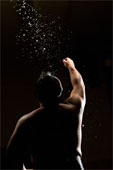In Japan, for the sumo fan, it's more like those elementary schools who don't have the traditional, agrarian-minded "summer vacation" break. It's year-round, baby.
The Nihon Sumo Kyokai, or official Grand Sumo organization, runs the show. They schedule tournaments every other month during six months of the year. It's pretty set. January is Tokyo. March is Osaka. Then in May, it's back to Tokyo. July takes the big guys over to Nagoya in western Japan. September is Tokyo again. And in the fall, November's tournament is held in Fukuoka. And the next year it starts all over again.
Tournaments are 15 days long, and each wrestler (in the upper tiers) wrestles once each day of the tournament. The lower ranks often will just wrestle every other day. Events are televised and radio broadcasted. As a gaijin, I found the play-by-play announcement on NHK (radio) of the sumo match fascinating. I didn't understand a ton, but it was great!
It seems to me that the Tokyo dwellers get the lion's share of the sumo fun. Their arena is the national arena, the Kokugikan. (Which means national arena.) It is in the Ryogoku neighborhood of Tokyo, kind of in the south and east quadrant. There's a train station (Japan Rail Sobu Line) right near the arena for fans to arrive via. The building is square and has a traditional Japanese tile roof. You can see it on Google Earth if you zero in. Here's a picture of the outside, then what it looks like inside. And the seating is all square inside, with the dohyo, or ring, in the center.
I just looked it up here and all the ringside tickets are sold out for the May tournament in Tokyo. If somebody is lucky enough to be going to Japan (I wish it were me!) tickets are available by phone, internet (both with English options), and in various stores like Circle K (in Japan, of course), and at the box office of the Kokugikan. ii naa. (Which means, "I wish...")
In spite of the fact that the Tokyo folks get a lot of sumo there, the outlying prefects do get the blessing of the sumo show in the off months. This is called Hana Sumo (or flower sumo.) Rikishi (wrestlers) travel to the various geographical areas of the country. For instance, the northern/eastern part of Japan is called Tohoku. The rikishi will take a couple of weeks and do exhibition tournaments in Tohoku prefectures like Aomori and Akita and Miyagi prefectures. Then a different interim month they will travel to the Kanto region and tour Chiba, Gunma, and Tochigi prefectures just for show. The champions draw the crowds, but it is also a time when the newbies can debut in the ring. These tournaments don't count toward ranking, but they are great for practice and experience for the younger ranks. Sometimes the champs don't take these very seriously, and it's just for show. The fans don't have to wait long, however, for a real display of sumo power. In Japan, sumo is never out of season.





Hi Jen. Nobody is commenting on your blog. :( I will though. I like it so far. I wish college football season was all year. But then the athletes don't seem as conditioned as the rikishi. :)
ReplyDeleteThanks, John B. Just one glimpse at the rikishi on skis will tell you hardly *anyone* is as conditioned as these fellows.
ReplyDeleteCongrats on being my first comment!